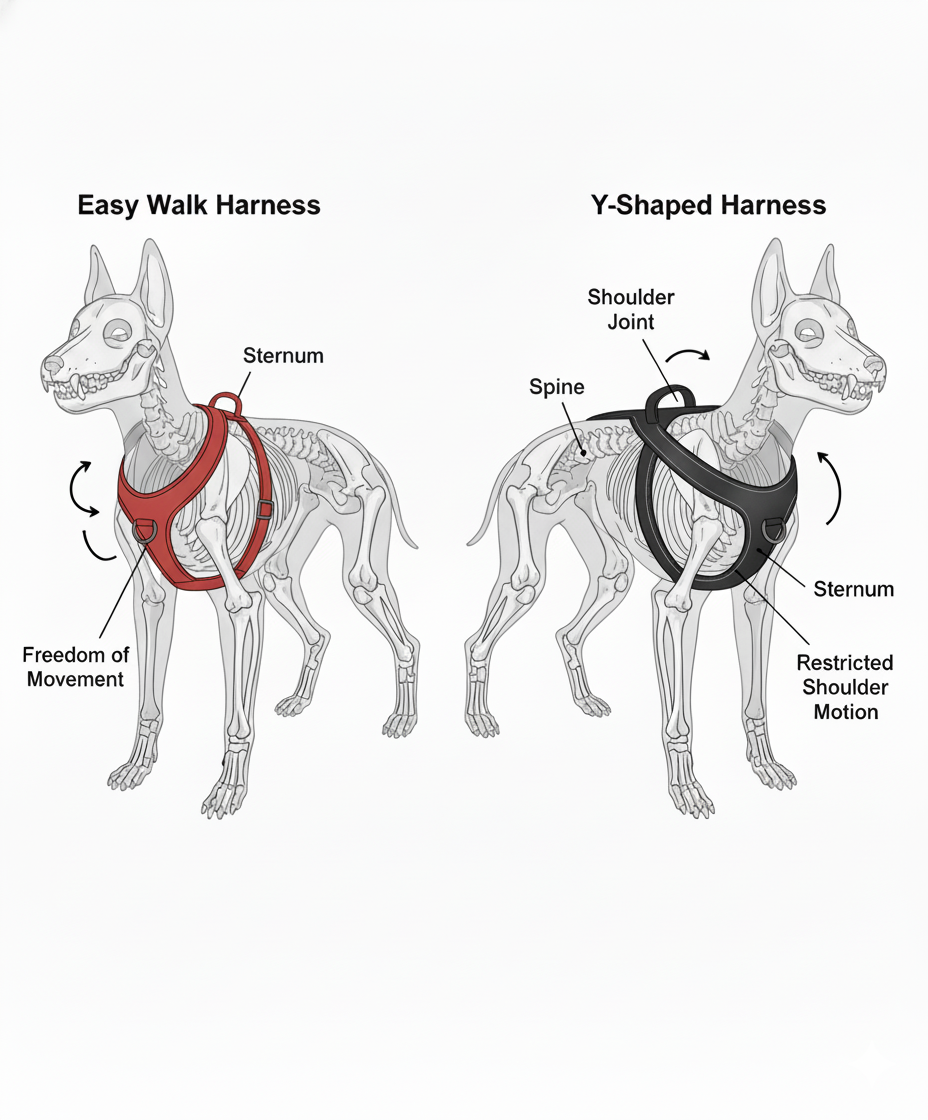The popular Easy Walk harness promises to stop pulling instantly. But you may have heard whispers that its design can cause shoulder problems. Is this top-selling product secretly harmful to your dog?
The Easy Walk harness is not inherently "bad," but its design can be problematic. Its horizontal chest strap can restrict a dog's natural shoulder movement and alter their gait. While effective for pulling, many experts now recommend Y-shaped harnesses for better long-term joint health.

As a product designer, I've spent countless hours analyzing harness mechanics. The Easy Walk is a fascinating case study because its effectiveness is undeniable, but so are the biomechanical concerns. It represents a trade-off between control and kinesiology. For a fellow designer, understanding this conflict is key to creating the next generation of better, safer dog gear.
How does the Easy Walk's tightening chest strap actually work?
You see its unique design, with the D-ring on a loop across the chest. It's different from a simple front-clip harness, but how does that tightening feature function to stop pulling?
The Easy Walk harness uses a front-clip martingale loop. When the dog pulls, the chest strap gently tightens, applying pressure across the chest and shoulders. This tightening action, combined with the sideways steering from the front clip, discourages the pulling behavior effectively.

I remember the first time I dissected an Easy Walk harness in my workshop. Its brilliance is in its simplicity. The design is clever, but it's that very design that also creates the controversy.
The Martingale Chest Loop
The core of the design is the "martingale" feature on the chest strap. It's a limited-cinch mechanism. When a dog pulls forward, the leash attached to the D-ring on this loop causes the strap to tighten. The two O-rings on either side of the loop allow it to slide smoothly, applying consistent pressure. The intention is to create an immediate, gentle consequence for pulling. It's not a sharp correction, but more of a constricting hug that discourages the behavior.
Combining Steering with Pressure
The design pairs this tightening action with the steering effect of a front-clip harness. So, when the dog pulls, they are simultaneously turned back toward the handler and feel the pressure across their chest. This two-pronged approach is why it's so effective for many dogs. As a designer, I appreciate the user-centric problem-solving here, but it's our job to ask if the solution creates a new, more subtle problem for the dog.
Could this design really harm a dog's shoulders and gait?
You want to solve pulling, but not by creating a new physical problem for your dog. So, what is the real biomechanical risk of that horizontal chest strap sitting across the dog's front?
Yes, the design poses a significant risk to a dog's natural gait. The horizontal strap sits directly across the major shoulder muscles, physically blocking the full forward extension of the front legs. This can cause a shortened, stilted stride, potentially leading to repetitive stress injuries over time.

This is the most critical point of debate, and where my focus as a designer always lands. I once consulted for a canine physical therapist who used slow-motion video to show me the impact. The evidence was clear.
The Problem with a "T-Strap" Front
The Easy Walk and similar harnesses create a "T" shape on the dog's chest. That horizontal bar of the T lies right over the point of the shoulder. A dog's front legs are meant to move like pistons, reaching forward and pulling back. When a strap impedes that forward motion, the dog is forced to compensate. They might take shorter steps, or swing their legs out to the side in an unnatural way. This isn't just awkward; it changes how forces are distributed through their joints, from the wrist all the way up to the shoulder and spine.
Y-Shaped Harnesses: The Ergonomic Alternative
This is why I almost always advocate for a Y-shaped harness design. This style fits like a collar around the neck and has a single strap that runs down the breastbone, splitting to go around the dog's torso.
| Feature Area | Easy Walk ("T-Strap") Design | Y-Shaped Harness Design |
|---|---|---|
| Shoulder Fit | Sits across shoulder muscles | Clears the shoulders completely |
| Gait Impact | Can restrict forward leg extension | Allows for full, natural range of motion |
| Pressure Area | Concentrated on a horizontal line | Distributed along the sternum (breastbone) |
| Ergonomic Pro | Effective tightening mechanism | Works with the dog's natural anatomy |
For a designer like Frank, the choice is clear. If our goal is to enhance the dog's well-being, we must design products that respect their natural anatomy.
How can we design a better no-pull harness?
Knowing the risks of the Easy Walk design, what's a better solution? How can we take the effective no-pull concept and integrate it into a safer, more ergonomic product?
A superior no-pull harness would combine the steering principle of a front clip with a Y-shaped front that ensures total shoulder freedom. Using padded, high-quality materials, multiple adjustment points, and lightweight hardware would create a tool that is both effective and biomechanically sound.

This is the exact challenge I give to the design teams I consult with. We don't have to sacrifice a dog's physical health for the sake of leash manners. We can innovate.
The Blueprint for the Ideal Harness
Let's build a better harness on paper. First, we start with a Y-shaped chassis. This is non-negotiable. The harness must clear the shoulder joints. Next, we strategically place a reinforced D-ring at the center of the chest on the sternum strap. This gives us the no-pull steering effect without any tightening mechanism. For many dogs, this redirection is all that's needed.
Adding Gentle Pressure, Safely
If a tightening feature is desired for stronger pullers, we can reimagine it. Instead of a simple strap that constricts the shoulders, we could design a system where pressure is applied more broadly and gently across the padded sternum strap. The key is to avoid any mechanism that shortens the dog's stride. We can also use smart materials, like webbing with a bit of elastic give, to provide feedback without a hard stop. The design should focus on communication, not restriction. For example, a leash attached to both the front and back clips via a special double-ended leash offers incredible control without compromising gait.
Conclusion
The Easy Walk harness is a tool with known risks to a dog's gait. For optimal safety and comfort, I always recommend choosing a well-fitted, Y-shaped no-pull harness instead.
Cindy Long is the Sales Manager of Raysunpets and a pet lover with over 12 years of experience in exporting pet products. She specializes in providing customized dog chest carriers, leashes and pet accessory solutions for the European and American markets, always focusing on the real needs of customers and pets, and is committed to creating high-quality, practical and comfortable products that allow fur kids to live happier lives.

